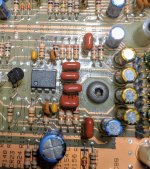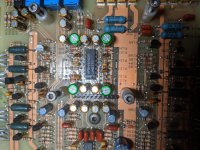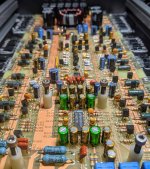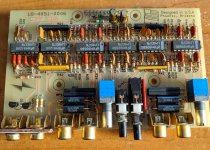Total noob question here. I did some searching but cannot find the info I'm looking for.
I'm doing a restoration and enhancement of an old PPI PC4400.2 to go in my car. I have already done the following
I'm doing a restoration and enhancement of an old PPI PC4400.2 to go in my car. I have already done the following
- Replacement of all electrolytics
- Larger carbon resistors replaced with 1% wirewound equivalents
- Corrected a previous repair job by replacing odd FETs with all new matching pieces
Attachments
I'm now realizing I'm completely wrong, a 2-channel op amp can't possibly be the input for a 4-channel amplifier that has a separate input for each channel. So the LM837 on the board I'm guessing is the output and the 6 other LM837's on the actual pre-amp board are the inputs. Would a OPA1664 be a suitable replacement for the LM837?
Attachments
Just thinking aloud: non Designers often think that a better design is the same old one but with "better parts"
It ain´t so.
Best case, nothing will audibly change (although sometimes a delicate Lab test might find some minute difference) , worst case you can degrade performance, even make amp unstable.
It ain´t so.
Best case, nothing will audibly change (although sometimes a delicate Lab test might find some minute difference) , worst case you can degrade performance, even make amp unstable.
You are right, I'm nothing close to a circuit designer/engineer, I just like to learn by trying different experiments. Comparing the LM387 to the OPA1664 on paper shows that it is compatible, so shouldn't degrade performance then, right? The differences that appeal to me are
- Higher slew rate: 17 vs 10
- Higher gain band width: 22 vs 10
- Lower noise voltage: 3.3 vs 4.5
- Lower THD .00006 vs .0015 - although I'm sure inaudible anyway
The 1664 has a higher bandwidth as well, I’d say it’s worth a try, but still no guarantees as to how much the better part will be realized, or how much the rest of the amp will be a dominant factor.
It looks great, probably sounds nice too.
Yep, that's what I was thinking as well, thanks for the input. I'm going to give it a go and see how it sounds.
It does currently sound good, alot cleaner than it did with very light but accurate high end.
Make sure to give it plenty of time to run, off and on for about a couple weeks if you haven’t already with the new caps. That will give you a stable point from which to evaluate any possible improvement from new parts. There may possibly have been some advantage to the limiting effect from the existing opamp. Doubtful, but still a possibility.
You are right, I'm nothing close to a circuit designer/engineer, I just like to learn by trying different experiments. Comparing the LM387 to the OPA1664 on paper shows that it is compatible, so shouldn't degrade performance then, right? The differences that appeal to me are
Otherwise, output current is the same at 40mA per channel for both. I understand that I may never hear the difference but that's part of the reason I'm wanting to try it in the first place, to see what happens.
- Higher slew rate: 17 vs 10
- Higher gain band width: 22 vs 10
- Lower noise voltage: 3.3 vs 4.5
- Lower THD .00006 vs .0015 - although I'm sure inaudible anyway
5. Higher current noise, 1pA/√Hz v. 0.7pA/√Hz
So the overall noise may well be higher, not lower. You'd need to check the flicker-noise knee freqs too.
The decoupling requirements for the two chips might be different. Also the need for stabilizing capacitors in feedback networks may differ between the chips.
- Status
- This old topic is closed. If you want to reopen this topic, contact a moderator using the "Report Post" button.
- Home
- Amplifiers
- Chip Amps
- Can I replace JRC2068D with LME49723



